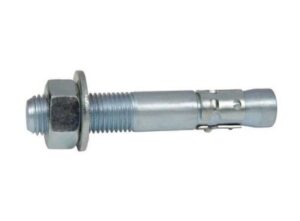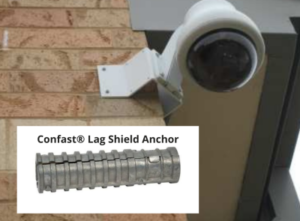It is essential to gather information about concrete fasteners for signage and how to select the right one for your application. Whether adhereing a sign to brick or block one must purchase the most effective concrete anchors.
Focusing on the answers to the following questions will assist in the selection of the right fastener:
What Type of Concrete Fasteners is Needed?
Wedge Anchors
Wedge anchors should only be used in solid concrete. They should never be used in brick or block. These anchors come in a variety of diameters from 1/4″ to 1-1/4″ and lengths ranging from 1-3/4″ to 12″. Wedge anchors are available in zinc plated, hot-dipped galvanized and stainless steel. The wedge anchor comes complete with nut and washer and also has excellent holding values in concrete.
The wedge anchor installation process is simple and requires 5 steps:
- Drill a hole in the base material a minimum of 1/2″ deeper than the wedge anchor’s embedment. Use a carbide bit and hammer drill.
- Clean out the hole using compressed air and/or a wire brush.
- Place the nut on the end of the anchor before hammering into the hole in order to protect the threads during installation.
- Hammer the anchor through the hole in the sign into the hole drilled in the base material deep enough so a portion of the threads is below the surface of the sign.
- Tighten the nut 3 or 4 revolutions to set the wedge anchor. Torque values can be found on the wedge anchor technical information page.
** See all diameters, lengths, and prices for wedge anchors.
Sleeve Anchors
Sleeve anchors are versatile fasteners that can be used in concrete, brick, and block. These anchors come in diameters ranging from 1/4″-3/4″ and lengths from 5/8″ to 6-1/4″. Many diameters are available in zinc plated and stainless steel. A variety of head styles is also available for many of the sleeve anchors including flat countersunk, round head and hex nut. The hex nut has the most choices in terms of length and diameter. Both the flat countersunk and round head is only available in the 1/4″ and 3/8″ diameter only. These anchors come complete with both nut and washer and their length is measured from underneath the nut and washer.
The sleeve anchor installation process is relatively simple:
- Drill a hole in the base material a minimum of 1/2″ deeper than the sleeve anchor will be embedded. Keep in mind that anchor size is hole size. Use the correct carbide bit and hammer drill.
- Clean out the hole of all debris.
- Hammer the sleeve anchor through the sign’s hole and into the hole drilled in the base material until the washer is snug with the sign.
- Finger tighten the nut and use a wrench to turn the nut several times until it is tight. Do not over tighten or the anchor may spin in the hole.
** View all sleeve anchor diameters, lengths, and prices to determine if these are the right anchors for your application.
Tapcons – Concrete Screws
Tapcons are versatile fasteners that can be used in concrete, brick or block. They are available in blue Climaseal® and 410 stainless steel. Standard blue Tapcons come in two different diameters: 3/16″ and 1/4″. The larger diameter Tapcon is available in 3/8″, 1/2″, 5/8″ and 3/4″. These large diameter screws are only available in hex washer head. The length of screw needed will be determined by the thickness of the sign. The standard blue screws also require a minimum embedment of 1″ and a maximum embedment of 1-1/4″.
Using Tapcons are fairly simple:
- Using the proper diameter carbide drill bit, drill a hole in the base material a minimum of 1/2″ deeper than the screw to be embedment into it.
- Use a carbide bit and also a hammer drill. Remember that the hole size should also be slightly smaller than the diameter of the screw being used.
- Clean out the hole with compressed air and/or a wire brush.
- Drive the screw through the hole in the sign using a drill or wrench until snug. Make sure that if you are using a drill, it doesn’t spin the screw too fast and strip the threads or over torque.
Into what base material will the sign be attached?
While there are three different types of base material that a sign can be attached to, there are issues associated with each one. If the base material is concrete, make sure that the fasteners being used are also not set too close together. Generally, they need to be installed about 10x their diameter apart from each other. It is also important to make sure that the anchors are not within a distance equal to about 5x their diameter from any unsupported edge.
When attaching a sign to brick or block, the fastener can be placed either in the mortar joint or in the brick/block itself. In the mortar joint, the holding values attained will be determined by the quantity as well as the quality of the mortar. If the concrete fasteners are placed in the brick or block itself, then the holding values will be determined by the quality of the base material and whether the anchor is in the hollow or solid section.
How heavy is the sign?
There is a correlation between improved holding values of an anchor with the size of its diameter. Generally, the larger the diameter of the anchor and the deeper the depth of the embedment, then the higher the holding value will become.
What is the diameter of the hole in the sign for the placement of the fastener?
It is important to check that the diameter of the anchor chosen will fit through the hole in the sign also. Concrete anchors require a slightly larger hole in the sign than the designated diameter of the anchor. For example, a 1/4″ concrete anchor requires a 5/16″ hole in the fixture.
Will the signs be placed in moist or wet environments?
Comparisons
304 Stainless Steel
- Used in submerged, wet environments
- Used only in solid concrete
316 Stainless Steel
- Used in caustic, wet and/or moist atmospheres
- Used only in solid concrete
Hot Dipped Galvanized
- Used in moist environments
- Used only in solid concrete
Why not explore the opportunities to bypass the wedge anchor distributor?
Tap into technology, and purchase directly from the manufacturer by ordering online at www.concretefasteners.com


















